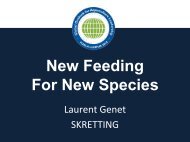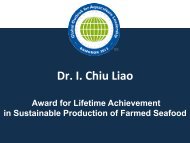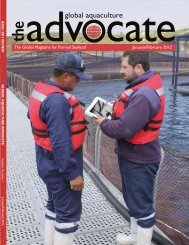May/June 2010 - Global Aquaculture Alliance
May/June 2010 - Global Aquaculture Alliance
May/June 2010 - Global Aquaculture Alliance
You also want an ePaper? Increase the reach of your titles
YUMPU automatically turns print PDFs into web optimized ePapers that Google loves.
marketplace<br />
Fish Farming Supports<br />
Ecological Efficiency<br />
<strong>Aquaculture</strong> diets are increasingly utilizing sustainable ingredients that lessen reliance<br />
on marine resources while maintaining nutritional values. Kona Blue Water Farms has<br />
cultured its Almaco jacks on diets yielding under 2:1 wet fish in, wet fish out, with tank<br />
trials approaching 1:1 or less.<br />
Summary:<br />
There is a widely promoted<br />
misconception that eating wildcaught<br />
fish is better for the<br />
oceans than eating farmed seafood.<br />
On a global basis, however,<br />
sustainably farmed fish may represent<br />
60 times more efficient use<br />
of anchovies and other baitfish<br />
resources than wild fish. Farmed<br />
fish have more efficient life cycles,<br />
more efficient trophic transfer<br />
and more efficient by-catch.<br />
Many anti-aquaculture activists would<br />
have you believe that eating wild-caught<br />
fish is better for the oceans than eating<br />
farmed fish. An examination of some<br />
fundamentals of ecological efficiencies,<br />
however, suggests that, in fact, the converse<br />
might hold true. Eating farmed fish<br />
is almost as good as eating anchovies –<br />
the lowest fish on the food chain. Indeed,<br />
it may be better!<br />
Eat Low?<br />
Marine scientists are all of one mind:<br />
The best way to take care of our oceans is<br />
to eat at the base of the marine food<br />
chain. Our seas would be more sustainably<br />
managed if everyone ate anchovies or<br />
similar small “clupeiform” fish like herrings,<br />
sardines, menhaden and the like.<br />
But part of the tragedy of the oceans<br />
is that most humans love to eat the larger<br />
fish – tuna, swordfish, cod, Chilean seabass<br />
and the like. We crave these fish<br />
because they offer big, thick fillets, and<br />
they taste great. Many are also, alas, the<br />
same species that now totter on the edge<br />
of economic extinction.<br />
We must therefore objectively examine<br />
the true environmental cost – in terms<br />
of anchovy inputs – of wild-caught fish<br />
versus sustainably farmed fish. There are<br />
three primary considerations.<br />
Farmed Efficiencies<br />
Firstly, farmed fish have it easy. They<br />
don’t have to hunt for food, flee for their<br />
lives or reproduce. Farmed fish are also<br />
usually harvested at a younger age, so<br />
Neil Anthony Sims<br />
President<br />
Kona Blue Water Farms, LLC<br />
P. O. Box 4239<br />
Kailua-Kona, Hawaii 96745 USA<br />
neil@kona-blue.com<br />
most of their diet goes into fast, efficient<br />
growth. Larger wild fish must expend<br />
energy sustaining their biomass, staying<br />
alive and seeking a spawning mate. A<br />
farmed fish’s life cycle might therefore be<br />
three to 10 times more efficient than that<br />
of a wild fish.<br />
Secondly, aquafarmers can increasingly<br />
use sustainable substitutes in fish diets to<br />
lessen reliance on marine resources. Fish<br />
feed formulations are now including more<br />
alternative proteins and oils, and moving<br />
toward a point where the efficiency of protein<br />
conversion can approach 1:1 with no<br />
net loss of marine protein.<br />
By contrast, wild fish are subject to<br />
the laws of trophic transfer, where only<br />
10% of their prey’s food value is transferred<br />
up each step of the food chain. If a<br />
swordfish eats a mackerel that earlier ate<br />
an anchovy, then there are two such<br />
steps, compounding the costs. A swordfish<br />
may therefore need to eat 100 kg of<br />
“anchovy equivalents” to increase its<br />
weight by 1 kg.<br />
Finally, farmed fish don’t have bycatch.<br />
Farmers only harvest the fish in<br />
their pens. Anchovy fisheries also rarely<br />
have any extraneous take, as they target<br />
pelagic schools of one species of baitfish.<br />
Other wild fisheries, however, use trawling,<br />
dredging or similar indiscriminate<br />
methods that take all the fish caught in the<br />
net or haul up whatever is on the hook.<br />
Unwanted fish – either unsalable,<br />
undersize or over the quota – are usually<br />
thrown back dead. Experts estimate that<br />
around 28% of global wild harvest is discarded<br />
as by-catch. That’s a lot of wasted<br />
anchovy equivalents.<br />
Compounded Costs<br />
So if an 0.5-kg platter of sashimi is<br />
sourced from a fish farm using sustainable<br />
diets, then the environmental input required<br />
could be close to 0.5 kg of Peruvian anchovies.<br />
For an 0.5-kg platter of wild-caught<br />
tuna, however, the cumulative cost could<br />
range from 2 to 5,500 kg of anchovies. See<br />
Table 1, which shows the compounded cost<br />
in terms of anchovy equivalents for<br />
farmed and wild-caught fish.<br />
Sustainability farmed fish may therefore<br />
be up to 11,000 times more ecologically<br />
efficient than wild-caught. The best<br />
estimate for a global efficiency differential<br />
between wild and farmed fish is around<br />
60 times.<br />
Life cycle efficiency 1<br />
Trophic transfer efficiency 2<br />
By-catch efficiency<br />
Compounded cost<br />
Farmed Fish wild-Caught Fish <strong>Global</strong> Mean<br />
58 <strong>May</strong>/<strong>June</strong> <strong>2010</strong> global aquaculture advocate global aquaculture advocate <strong>May</strong>/<strong>June</strong> <strong>2010</strong> 59<br />
Low<br />
Estimate<br />
1<br />
1<br />
1<br />
1<br />
High<br />
Estimate<br />
1<br />
8<br />
1<br />
8<br />
Based on this, which has more wanton<br />
waste – farmed or wild? And if you<br />
are an ocean-conscious consumer, which<br />
should you have on your plate?<br />
Table 1. Relative ecological efficiencies<br />
of farmed and wild-caught fish.<br />
Low<br />
Estimate<br />
3<br />
10<br />
1<br />
30<br />
High<br />
Estimate<br />
10<br />
100<br />
11<br />
11,000<br />
Ratio of Wild<br />
To Farmed<br />
6<br />
7.3<br />
1.33 57<br />
1. There are no published estimates of the relative life cycle efficiencies of farmed and wild fish. However,<br />
fish that reach reproductive age in captivity can see feed-conversion ratios increase by factors<br />
or 5 or 10 over juvenile and sub-adult fish. Natural mortality and the nutritional cost of maintenance<br />
of basal metabolic processes during periods of food deprivation also increase the “economic” feedconversion<br />
ratio for wild fish populations.<br />
2. In 1997, feed-conversion efficiencies (FCEs) for farmed marine fish and farmed salmon were reportedly<br />
around 5:1 and 3:1, respectively. By <strong>2010</strong>, however, FCEs are projected to reach 1.5:1 for<br />
farmed marine fish and as low as 1.2:1 for farmed salmon.<br />
3. In 2005, J. M. Harrington and co-authors reported a “nationwide discard to landings ratio” of 0.28.<br />
However, for highly selective fishing methods, such as harpooning, by-catch is effectively zero.<br />
global aquaculture<br />
Join the<br />
world’s<br />
leading<br />
aquaculture<br />
organization.<br />
®





